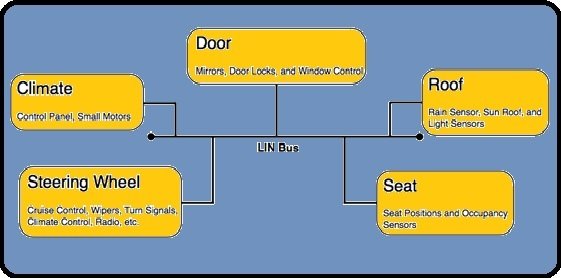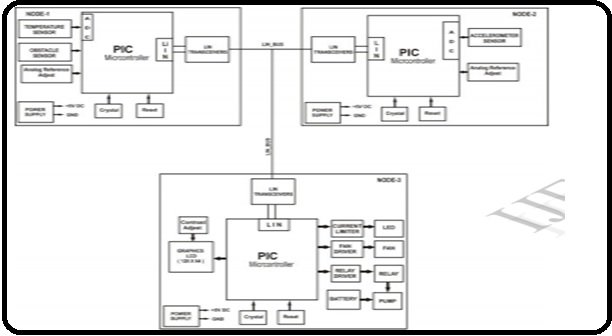What is LIN Communication Protocol? The word LIN stands for local interconnect network. It is advanced form of a network that has been currently used in automotive sectors. If we talk about previous network in automotive sector, then it was full of mechanically components but now it has been replaced with intelligent mechatronics system. Because this system consists of lot of wires and communication components therefore it is not so much easy to handle these components. But LIN communication protocols have made this so much easy with the help of a single bus bar and this bus bar is called LIN bus bar. This bus bar is a single master or multiple slave bus that transmit data with the help of single wire. It consists of a sub system that based on a serial communication protocol and is invented to be used for simple switching applications such as door locks, sun roofs, rain sensors, car seats, mirrors and steering wheels etc. The simple LIN communication protocol bus is shown in figure 1 in which LIN communication bus bar is controlling different part of the vehicle. It has many applications in embedded systems projects. 
Figure 1 A Simple LIN Communication Protocol Bus with Different Parts of Vehicle
LIN communication Protocol
LIN protocol is a serial wired communication protocol for electronic devices which consist of one master and one or more slaves, but it does support multiples slaves. For starting or receiving data to LIN bus, LIN master uses different predefined scheduling tables and these scheduling tables have different relative timing when data send time is start. Each data consist of LIN frames and every LIN frames consists of two pairs such as header and response. LIN master always sent data to header pair, then header pair sent data to response pair and response pair sent this either to dedicated slave or LIN master. This data is sent with in LIN in the form of eight bytes, in which one start bit and one stope bit is also involved. The timing of this data is set by LIN master through clock source and the smallest time of one-bit is 52 micro second @ 19.2Kbits/s.
How LIN Communication protocol Works?
The working of a LIN bus is very simple. Every LIN system consists of a one master LIN bus device and multiple slave devices which are interconnected with each other. Every slave has a single task to perform but all these tasks are totally controlled though master LIN bus device. The message which is transfer from LIN bus device to slave deice is called message frame and it is divided into message header and message frame. Message header which always sent the message from master node to slave, it consists of three different fields such as break, synchronization (Sync) and identifier (ID). Similarly, the message response which always receive the message which is sent by master node, it consists of two different fields such as data and checksum. The block diagram of LIN message frame is shown in figure 2
Figure 2 LIN Message Frame
For stating communication when message is sent from master LIN bus device to message header then break field check number of bits this data which comprises this data into 13 dominant bits. Then Sync field synchronize this data means it defined this data into x55 character and allows the slave device to automatic set the baud rate of this data. After that the ID field which is final field of message header. It provides the identification of each message on network and finely decided whose slave node would be responded on this data or message. Similarly, the Data field in message response checks this data, convert it into zero to eight bytes and then send it to slave bus. The checksum field checks the algorithms of this data and finally send this data to slave bus.
Types of LIN communication protocol Frames
The specification of LIN 2.0 is further classified into six LIN frames.
- Unconditional LIN Frame
- Event triggered LIN Frame
- Sporadic LIN Frame
- Diagnostic LIN Frame
- User defined LIN Frame
- Reserved LIN Frame
- Unconditional LIN Frame: This type of LIN frame always carry signal and identify it from range 0 to 59 (0x00 to 0x3b). All the subscriber of this LIN frame will receive the signal and use it for their applications.
- Event Triggered LIN Frame: This type of LIN frame increases the responsiveness of LIN cluster means different nodes of slave without assigning to much bus bandwidth during any sudden event occur.
- Sporadic LIN Frame: This type of LIN frame is provided by master bus so that the collision could not occurred.
- Diagnostic LIN Frame: This type of LIN frame always carries configured or diagnostic data in the range from 0 to 8 bytes.
- User defined LIN Frame: This type of LIN frame carries all types of data means all kinds of information data and its identifier is 62 (0x3E).
- Reserved LIN Frame: This type of LIN frame is not used in LIN 2.0 cluster and its identifier is 63 (0x3F).
LIN communication protocol Working Example
Every LIN system consists of a one master and one or more LIN slaves. If we take example of an automotive industry, then LIN bus is connected between smart sensor and electronic control unit (ECU) in which CAN bus use as a gate way. Block diagram of this vehicle LIN system is shown in figure 3. this system has made with the help of three microcontrollers
Figure 3 Block Diagram of Vehicle LIN System
Different vehicles sensors are connected with this LIN system such as wheel speed sensor, impact sensor, gyroscope, pressers break sensor and light sensor etc. These sensors are controlled through LIN bus and this LIN bus has made with three microcontrollers which are interconnected with each other with the help of single cable. Microcontroller are programmed with the help of c language and through these microcontrollers all the connecting sensors are controlled. All these sensors received the logic high or low signal through microcontroller and microcontroller received this signal through LIN bus. Any microcontroller could be used as a transmitter or receiver any time
LIN communication protocol Applications
LIN system is mostly used in advanced automotive industry therefore here we will explain its application when it is controlling different parts of the vehicle.
- Roof: LIN system is used at vehicle roof for controlling their sensors such as sun roof sensor and light control sensor.
- Steering wheel: It is used at vehicle steering wheel for controlling climate control sensor, wiper sensor, turning light sensor, radio and wheel lock sensor etc.
- Seat: It is used at vehicle seat where the position of seat is controlled through a motor and this motor is controlled through LIN system. Beside it is also used for controlling the occupant sensor and control panel sensor which are installed at seat.
- Door: It is used at vehicle door for controlling the position of motor which is installed with door mirror. Beside this it is also used for controlling central ECU (electronic control unit), window lift, seat control switch and door lock etc.
- Engine and Illuminations: It is also used for controlling engine sensor such as cooling fan motor sensor and illumination senor which controls the illumination of light.

